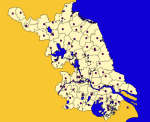Structure
Type of resources
Available actions
Topics
Keywords
Contact for the resource
Provided by
Years
Formats
Representation types
Update frequencies
status
Scale
Resolution
-

Major cities of Jiangsu Province, China at County level
-
Land area in km2 per 5 arcminute cell. This layer is part of the Global Roads Inventory Project (GRIP) dataset, developed to provide a more recent and consistent global roads dataset for use in global environmental and biodiversity assessment models like GLOBIO.
-

The World Port Index (Pub 150) contains the location and physical characteristics of, and the facilities and services offered by major ports and terminals world-wide (approximately 4300 entries). Entries are organized geographically in a tabular format, in accordance with the diagrams located in the front of the publication. The World Port Index publication can be freely downloaded in its entirety as an Adobe PDF document, a Microsoft Access database, or as an ESRI Shape file at the NGA (National Geospatial Intelligence Agency, USA) portal: http://www.nga.mil/NGAPortal/MSI.portal?_nfpb=true&_pageLabel=msi_portal_page_62&pubCode=0015
-
The Highways Density raster layer is part of the Global Roads Inventory Project (GRIP) dataset, developed to provide a more recent and consistent global roads dataset for use in global environmental and biodiversity assessment models like GLOBIO.
-
The Primary Roads Density raster layer is part of the Global Roads Inventory Project (GRIP) dataset, developed to provide a more recent and consistent global roads dataset for use in global environmental and biodiversity assessment models like GLOBIO.
-
The Local Roads Density raster layer is part of the Global Roads Inventory Project (GRIP) dataset, developed to provide a more recent and consistent global roads dataset for use in global environmental and biodiversity assessment models like GLOBIO.
-
The Tertiary Roads Density raster layer is part of the Global Roads Inventory Project (GRIP) dataset, developed to provide a more recent and consistent global roads dataset for use in global environmental and biodiversity assessment models like GLOBIO.
-
The Secondary Roads Density raster layer is part of the Global Roads Inventory Project (GRIP) dataset, developed to provide a more recent and consistent global roads dataset for use in global environmental and biodiversity assessment models like GLOBIO.
-
The Total Roads Density raster layer is part of the Global Roads Inventory Project (GRIP) dataset, developed to provide a more recent and consistent global roads dataset for use in global environmental and biodiversity assessment models like GLOBIO.
-

Infrastructures including vector layers that represent the network of roads, gravel roads, thacks, railroad lines and build-up areas in the CORB-contributing area of Angola. Source: Data provided by SINFIC, based on the Topographic Map of Angola (IGCA). This dataset is part of the GIS Database for the Environment Protection and Sustainable Management of the Okavango River Basin project (EPSMO). Detailed information on the database can be found in the “GIS Database for the EPSMO Project†document produced by Luis Veríssimo (FAO consultant) in July 2009, and here available for download.
 FAO Map Catalog
FAO Map Catalog